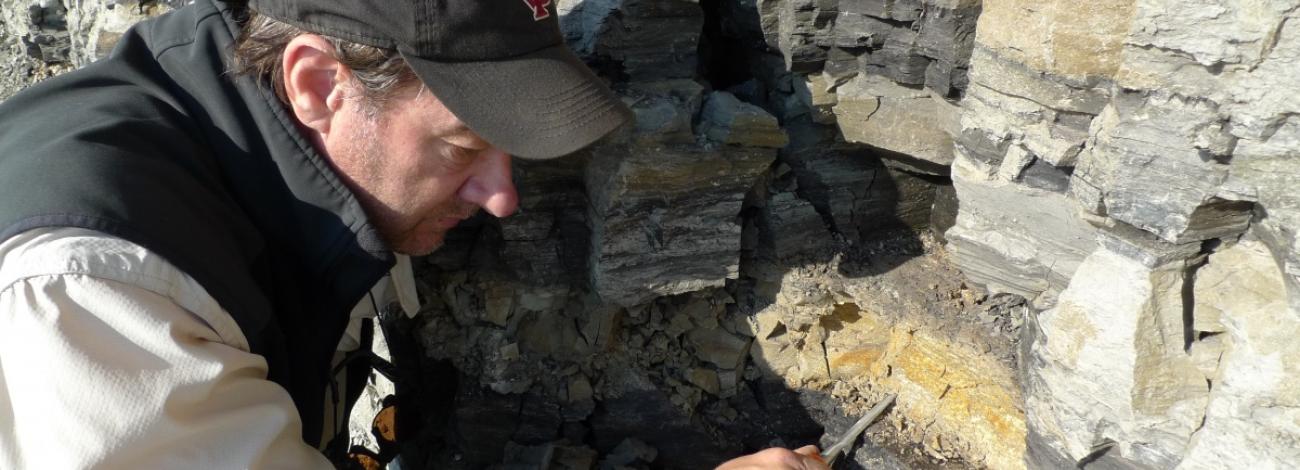Paleontology in Alaska
Fossils provide clues to many important and intriguing questions, from dinosaur extinctions to studies of plate tectonics (the geology of the Earth’s structural deformation). Consequently, public lands provide great outdoor laboratories and classrooms for the study of paleontology and also contribute significantly to public exhibits found in museums.
The paleological sites that the BLM manages is along the Colville river on the eastern edge of the National Petroleum Reserve on the north slop in Alaska. To date, at least 12 different types of dinosaurs have been discovered on the North Slope. The first type found, and the one from which the greatest number of bones have been recovered, was an impressive plant-eater called Edmontosaurus. This is a hadrosaur, a large duck-billed dinosaur that walked on two legs, stood up to 10 feet tall, was more than 40 feet long, and weighed 3 or more tons when fully grown.
The surprise is that some of the same polar dinosaurs that lived in Alaska, also lived in areas as far south as Texas. Paleontologists hope to understand in the future how the polar dinosaurs survived the cold, whether they were warm-blooded like modern birds and mammals or cold-blooded like modern reptiles, if dinosaurs migrated with the seasons, and why they became extinct.
Recent Finds
Ancient Grazer. Along the Colville River’s ancient sediments in the Liscomb Bone Bed, about 300 miles northwest of Fairbanks and 100 miles south of the Arctic Ocean, lies a trove of fossils. This is where researchers discovered the fossilized bones of the “ancient grazer,” Ungrunaaluk kuukpikensis (oo-GREW-naluck KOOK-pik-en-sis), Alaska’s newest hydrosaur and the fourth species unique to northern Alaska. Scientists sought assistance from Native Iñupiaq speakers to name this newest duckbilled dinosaur species. “Ugru” means plant grinding, “Naluk” means respectfully old, and “Kuukpikensis” is the Inupiat name for the area along the Colville River.
Nearing the end of the Mesozoic Era’s Cretaceous Period (146- 65 million years ago) when U. kuukpikensis lived, river systems crossed the ancient Arctic flood plain and vegetation thrived during the sunny summer season. These herbivorous polar dinosaurs likely roamed in herds and used their hundreds of grinding teeth to survive on coarse vegetation. They grew to 30-feet long.
Polar Bear Lizard. Meet the smallest carnivorous tyranosaurid dinosaur yet discovered, the Nanuqsaurus hoglundi or “Polar Bear Lizard.” It likely had a strong sense of smell to aid in the hunt of its prey, like Tyrannosaurus rex (T. rex). Half the size of T. rex, this dinosaur is about 20 feet long with a 2-foot skull, compared to T. rex at up to 45 feet long and a skull measuring up to 5 feet. This smaller, diminutive dinosaur roamed northern Alaska nearly 70 million years ago. This land was then part of an ancient subcontinent called “Laramidia.” Laramidia experienced cold weather and long periods of darkness and light. Daylight was limited or even nonexistent during the winter months. For the animals living there, food was probably scarce during the dark periods. The Alaska Nanuqsaurus discovery is a partial skull in three parts from the Late Cretaceous Prince Creek Formation (which dates to about 69.1 million years ago).
Pachyrhinosaurus perotorum, It weighs about four tons, stands seven feet high on four legs, and is about 18 feet long (roughly the size of a large rhinoceros). It eats plants, is about 70-million years old, and is from the Late Cretaceous. This is a new species of ceratopsid (horned) dinosaur, formally named the Pachyrhinosaurus perotorum, that Paleontologist Anthony R. Fiorillo, Ph.D., Dallas Museum of Nature and Science, and his team discovered on BLM-managed lands at the Kikak-Tegoseak Quarry near Alaska’s Colville River. The P. perotorum lived in herds in an Alaska that was warmer than it is today, demonstrating that the ancient Arctic was a rich biological ecosystem. How polar dinosaurs survived in these conditions is a key research question paleontologists are still working to answer. Fiorillo says the P. perotorum may have been food for Tyrannosaurus rex. One of the dinosaur skulls had teeth marks from the larger carnivore dinosaur.




